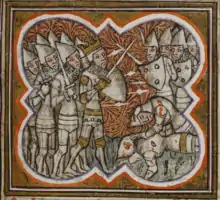Raoul I of Lusignan
Raoul I of Lusignan (born c. 1160/5 - Melle, May 1, 1219) was the second son of Hugh de Lusignan (d. 1169) and the grandson of Hugh VIII of Lusignan. He was a prominent nobleman in the region of Poitou, and lord (seigneur) d′Exoudun, de Melle, de Chizé, de Civray and de La Mothe. He also became Count of Eu (c. 1191), by marriage (de jure uxoris) to Alix d'Eu. Since the region of Poitou was contested between kings of France and England, local nobility was often changing sides. Up to 1201, Raoul was loyal to kings of England, but than changed his allegiance to king of France. He later rejoined the English side, and took part in the Battle of Bouvines (1214). For his services to the king England, he was granted possession of Hastings and Tickhill, in 1216. Earlier, he participated, as a young knight, in the Third Crusade, and later again in the Fifth Crusade, and died upon return. He was buried at the Priory of Fontblanche, in Exoudun.[1][2][3][4]

Family
By 1191, Raoul married a young noblewoman Alix d'Eu, heiress of the County of Eu (born c. 1180 – La Mothe-Saint-Heray, Poitou, May 1246).[5]
They had several children, including:
- Raoul II de Lusignan, Count of Eu (born c. 1200 – died in 1246).[6]
- Matilda de Lusignan (c. 1210 – August 14, 1241), who married Humphrey de Bohun, 2nd Earl of Hereford, 1st Earl of Essex and Constable of England. She was buried at Llanthony, Gloucester.[5]
As lord of Exoudun, he is known as: Raoul d′Exoudun, and should not be confused with a contemporary nobleman, Raoul of Issoudun (Raoul d′Issoudun), who was married to Margaret of Courtenay.
References
- Jourdain, Delisle & Wailly 1894, p. 449, 452.
- Painter 1955, p. 376.
- Power 2004, p. 111, 424-425, 497.
- Richardson 2011, p. 292-293.
- Pollock 2015, p. 101.
- Power 2004, p. 497.
Sources
- Jourdain, Charles; Delisle, Léopold; Wailly, Natalis de, eds. (1894). Recueil des Historiens des Gaules et de la France. 23. Paris: H. Welter.
- Painter, Sidney (1955). "The Houses of Lusignan and Chatellerault 1150-1250". Speculum. 30 (3): 374–384.
- Pollock, Melissa A. (2015). Scotland, England and France After the Loss of Normandy, 1204-1296: Auld Amitie. Woodbridge: The Boydell Press.
- Power, Daniel (2004). The Norman Frontier in the Twelfth and Early Thirteenth Centuries. Cambridge: Cambridge University Press.
- Richardson, Douglas (2011) [2004]. Plantagenet Ancestry: A Study in Colonial and Medieval Families (2nd ed.). Baltimore: Genealogical Publishing Company.